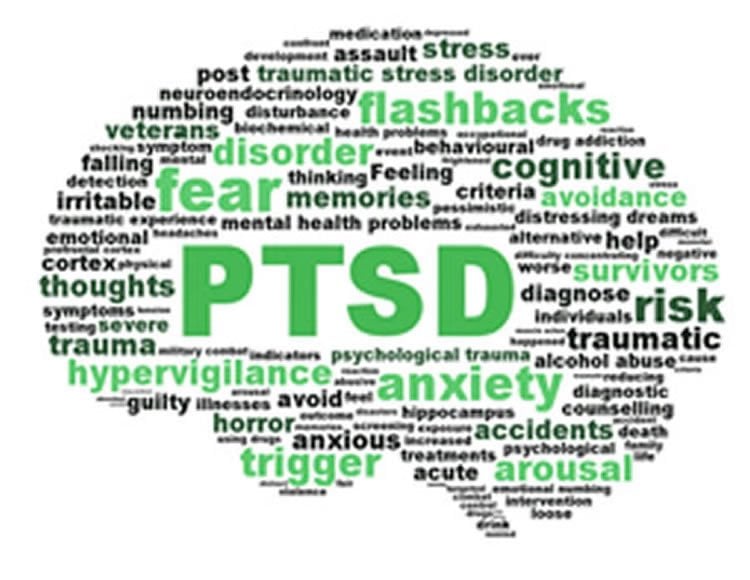Three-year mark shows little difference between treated and untreated individuals.
The majority of people with post-traumatic stress disorder (PTSD) recover after early treatment — but a substantial number still suffer for years after a traumatic event even with early clinical interventions, according to a study publishing online April 12, 2016 in The Journal of Clinical Psychiatry.
Over a 12-week period, researchers looked at several groups of non-military individuals suffering from PTSD (a total study cohort of 232 individuals) after a single traumatic event. All participants received either prolonged exposure therapy; cognitive therapy; treatment with selective serotonin reuptake inhibitors (SSRIs); or a placebo pill one month after the traumatic event. They also followed individuals who declined treatment. All were reassessed at five months and at 36 months.

While the groups receiving prolonged exposure and cognitive therapy showed a significant reduction of symptoms by five months (61% better than the other groups), and their symptoms remained low for three years, the other groups, including those who declined treatment, reached the same level of low symptoms by three years. In that sense, early-prolonged exposure and cognitive therapy significantly shortened the time to recovery, but did not reduce a three-year prevalence of PTSD.
“We assume that people living in an otherwise stable environment would have better conditions for long-term recovery than individuals who experience lengthy wars or live in a constant state of violence,” says Arieh Y. Shalev, MD, the Barbara Wilson Professor in the Department of Psychiatry at NYU Langone Medical Center, and a co-director of NYU Langone’s Steven and Alexandra Cohen Veterans Center. “This might explain part of their spontaneous recovery without initial treatment. However, what this study tells us at its core is that there is a significant public health challenge ahead. Individuals continually expressing initial PTSD symptoms, and who are resistant to early treatment, should be the focus of future research,” Dr. Shalev adds. “They are the ones who remain chronically distressed and disabled, and require care long after their traumatic incident. We need to find ways to identify these subjects, increase the early favorable responses to existing treatment, and find new ways to reduce the long-term burden of PTSD.”
This study continues the work of Dr. Shalev and colleagues who developed a computational tool that can identify individuals at high-risk for PTSD. In a study published last year in BMC Psychiatry, those at high-risk for PTSD could be identified in less than two weeks after they are first seen in an emergency room following a traumatic event.
Approximately eight million Americans (civilian and military populations) will experience PTSD in a given year, according to the U.S. Department of Veterans Affairs’ National Center for PTSD. Trauma is also very common in women; five out of ten women will experience a traumatic event at some point during their lifetime.
The study was performed by Dr. Shalev’s laboratory at Hadassah University Hospital in Jerusalem with researchers from Bar Ilan University also collaborating. The study was funded by the National Institute of Mental Health via a research grant to Dr. Shalev.
Source: Jim Mandler – NYU Langone Medical Center
Image Source: The image in the public domain.
Original Research: Abstract for “Long-Term Outcome of Early Interventions to Prevent Posttraumatic Stress Disorder” by Arieh Y. Shalev, MD; Yael Ankri, MA; Moran Gilad, MA; Yossi Israeli-Shalev, MA; Rhonda Adessky, PhD; Meng Qian, PhD; and Sara Freedman, PhD in Journal of Clinical Psychiatry. Published online April 2016 doi:10.4088/JCP.15m09932
Abstract
Long-Term Outcome of Early Interventions to Prevent Posttraumatic Stress Disorder
Background: Failing to prevent posttraumatic stress disorder (PTSD) has major clinical and public health consequences. This work evaluates the 3-year outcome of offering early interventions to survivors with acute PTSD.
Methods: Adults admitted consecutively to the hospital with acute DSM-IV PTSD were randomized, between June 2003 and October 2007, to 12 weeks of prolonged exposure (n = 63) or cognitive therapy (n = 40) or concealed SSRI (escitalopram; n = 23) versus placebo (n = 23). Eighty-two participants who declined treatment were followed as well. Treatment started 1 month after the traumatic event, and participants were reassessed 5 and 36 months later. Assessors were blinded to treatment allocation and acceptance. The Clinician-Administered PTSD Scale (CAPS) evaluated PTSD and PTSD symptoms. Self-reported symptoms, general functioning, and employment status were secondary outcomes. Participants lost to follow-up were missing completely at random.
Results: Prolonged exposure and cognitive therapy significantly reduced PTSD and PTSD symptoms between 1 and 5 months (mean CAPS total scores [95% CI] at 1 month: prolonged exposure = 73.59 [68.21–78.96] and cognitive therapy = 71.78 [66.92–78.93]; mean CAPS total scores [95% CI] at 5 months: prolonged exposure = 28.59 [21.89–35.29] and cognitive therapy = 29.48 [21.32–37.95], P < .001), and their results remained stable. At 3 years, however, the study groups had similar levels of PTSD symptoms (mean CAPS total scores [95% CI]: prolonged exposure = 31.51 [20.25–42.78]; cognitive therapy = 32.08 [20.74–43.42]; SSRI = 34.31 [16.54–52.07]; placebo = 32.13 [20.15–44.12]; and no intervention = 30.59 [19.40–41.78]), similar prevalence of PTSD (28.6%–46.2%), and similar secondary outcomes.
Conclusion: Early prolonged exposure and cognitive therapy accelerated the recovery from acute PTSD. Their effect remained stable, however, without reducing the 3-year prevalence of the disorder. The lingering prevalence of PTSD, despite efficient interventions, illustrates a nonremitting, treatment-refractory subset of survivors and outlines a major clinical and public health challenge.
Trial Registration: ClinicalTrials.gov identifier: NCT00146900
“Long-Term Outcome of Early Interventions to Prevent Posttraumatic Stress Disorder” by Arieh Y. Shalev, MD; Yael Ankri, MA; Moran Gilad, MA; Yossi Israeli-Shalev, MA; Rhonda Adessky, PhD; Meng Qian, PhD; and Sara Freedman, PhD in Journal of Clinical Psychiatry. Published online April 2016 doi:10.4088/JCP.15m09932






